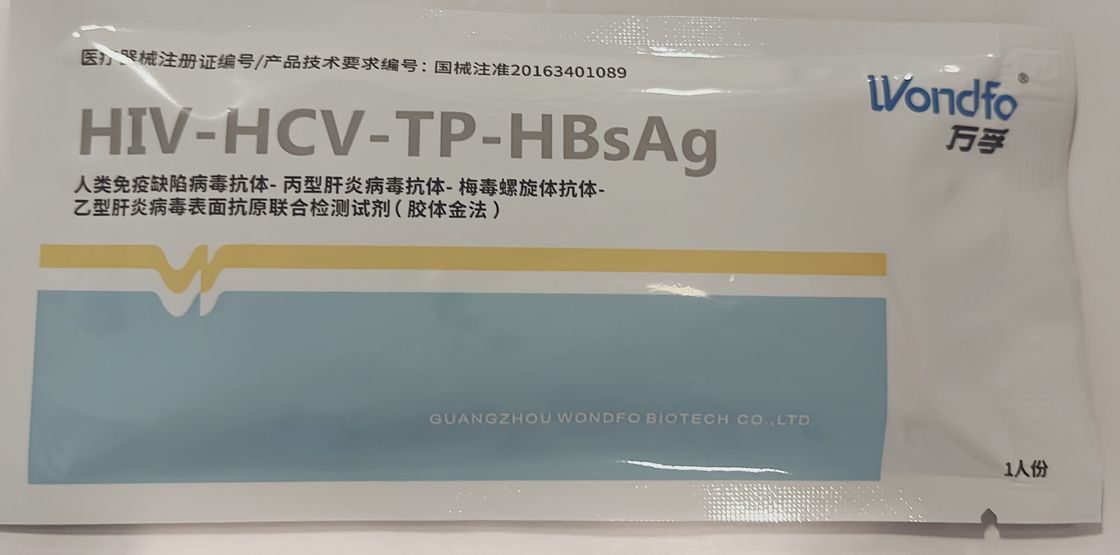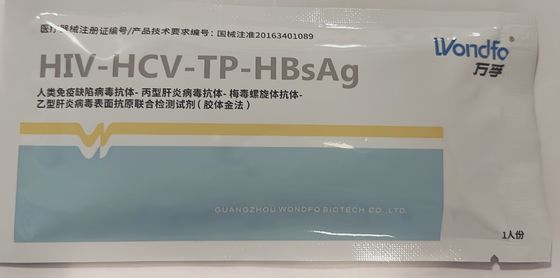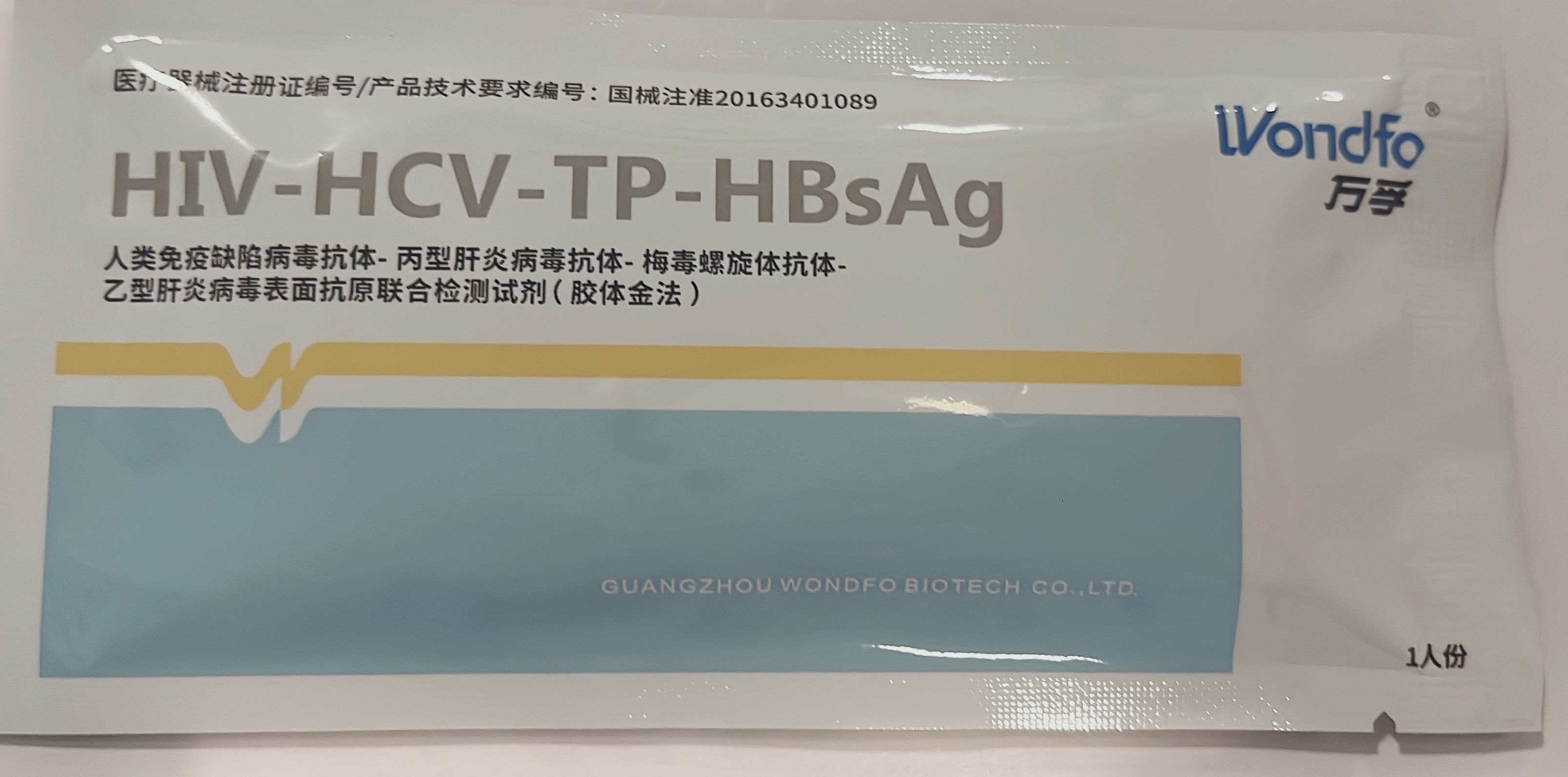Wanfu Human immunodeficiency virus antibody - Hepatitis C virus antibody - Treponema pallidum antibody Hepatitis B virus
[Intended Use]
This kit is used for the in vitro qualitative detection of Human Immunodeficiency Virus Antibody, Hepatitis C Virus Antibody, Treponema pallidum Antibody, Hepatitis B Virus Surface Antigen in human whole blood, serum or plasma.
AIDS, Acquired immunodeficiency syndrome (ADS), is a severely contagious immunodeficiency disease caused by infection with the human immunodeficiency virus (HIV). It mainly attacks the body's helper T-lymphocyte system, and once it invades the body's cells, it causes the immune system to lose its resistance, which leads to a variety of diseases and cancers being able to survive in the human body. There is a complete natural process from HIV infection to the onset of the disease
, and clinically this process is divided into four phases: acute infection, latency, pre-AIDS, and typical AIDS. The main routes of transmission of AIDS, blood transmission, and mother-to-child transmission.
Currently, serologic experiments are the main basis for HV laboratory diagnosis, and AIDS laboratory diagnostic techniques also include HVP24 antigen han assay, viral isolation, HV viral load determination, HV nucleic acid testing and CD,Newt cell counting. These methods are either used as a supplement to antibody detection methods as an aid to diagnosis or as a basis for determining prognosis and guiding therapeutic use of medication. This product applies colloidal gold immunochromatography technology and is suitable for the auxiliary diagnosis of human immunodeficiency virus infection.
Viral hepatitis C, referred to as hepatitis C, hepatitis C, is a viral hepatitis caused by hepatitis C virus (HCV) infection, which is mainly transmitted by blood transfusion, acupuncture, drug use and so on. Hepatitis C is a global epidemic that can lead to chronic inflammatory necrosis and fibrosis of the liver, and some
patients can develop cirrhosis or even hepatocellular carcinoma. Hepatitis C is transmitted through blood, mother-to-child, and close daily contact.
Viral hepatitis C is mainly manifested as acute viral hepatitis C, chronic viral hepatitis C, cirrhosis and so on. Clinical symptoms and signs of hepatitis C are not significantly different from those of other viral hepatitis, so the diagnosis of hepatitis C relies on virologic indicators in addition to liver function tests.
Syphilis is a chronic, systemic sexually transmitted disease caused by the pallid (syphilitic) spirochete. It is mainly transmitted through the , and can be clinically manifested as stage I syphilis, stage II syphilis, stage III syphilis, latent syphilis and congenital syphilis (fetal syphilis). Clinical manifestations are extremely complex, the early main
invasion of the skin and mucous membranes, late invasion of blood vessels, central nervous system and organs of the body.
Some specific syphilis (e.g., S, syphilitic cardiovascular disease, etc.) can be detected early and predicted by physical examination and some molecular biology methods to the corresponding organs (e.g., the aorta, cerebrospinal fluid) damage, such as echocardiography, magnetic magnetic (M) examination, and ultra-high-speed CT, etc. However, the main
detection of syphilis is to detect the damage to the organs. However, the main
detection is syphilis pathogenicity testing, umbilical cord blood specimens are taken for diagnosis of congenital syphilis, and cerebrospinal fluid should be tested for neurosyphilis.
Hepatitis B virus surface antigen (HBsAg)) is the small spherical particles and tubular particles contained in the outer shell portion of the hepatitis B virus, which is now divided into eight different subtypes and two mixed subtypes. With hepatitis B virus infection or persistent infection, HBsAg is the first serologic indicator to appear,
and generally lasts 4 to 12 weeks until it disappears during recovery. If positivity persists for more than 6 months it is chronic infection or carrier. High concentrations of 100 μg/m are often accompanied by HBeAg()+. Low concentrations of HBsAgi may be caused by the virus being in a low-replicating or non-replicating
state during the recovery phase of the infection, or by the virus and antigen having been partially cleared during treatment, or by viral mutation. Hepatitis B virus surface antigen can persist in a patient's blood for months, years, or even a lifetime, and is the most commonly used indicator for diagnosing hepatitis B virus infection.
【Storage conditions and expiration date】
C30℃保存,有效期24个月. After the aluminum foil pouch is opened, the test card should be used as soon as possible within 1 hour The diluent should be added immediately after opening and placed in a cool place, please use it within the expiration date
Production date: see product label
Expiration date: see product label.
[Sample Requirements]
Whole blood, serum and plasma samples can be used for testing.
The city's collection of Chinese days with the pull of coagulation consulting buy blood or in the blood collection tube to add anticoagulant, will buy the collection of samples to join and according to the uniform standby fingertips, ear hair, the tip of the vertical vein samples should be collected as far as possible after the fat with the pressure of up to the off by the Li not to talk about the use of substances
Blood in the collection of plasma: blood as soon as possible after taking the separation of serum, plasma, so as to avoid hemolysis, the separation of serum, plasma, serum, plasma, should be as soon as possible for the test of the setup when trying to the samples can be set at 2C a 8 ℃ refrigerator storage, more than 3 days should be placed in 20 ℃ frozen storage, courage before focusing on the recovery to the child temperature
to avoid repeated freezing and thawing.
[Test Methods]
Please read the instruction manual carefully before testing, the samples to be tested, the test reagents and other testing materials need to be equilibrated to room temperature, the test should be carried out at room temperature.
The operation steps are:
1 Tear the aluminum foil pouch along the cut part, take out the test card and lay it flat on the table and mark it.
2. For serum and plasma samples, aspirate serum and plasma with a pipette, and then add 2~3 drops vertically (about 60~80μ0 in the spiking hole. For whole blood samples, aspirate whole blood with a pipette, add 2 drops vertically (about 50μ0 in the spiking seed hole, and at the same time, add 1~2 drops of diluent
3. Observe the results within 15 minutes, and after 30 minutes the The results shown are invalid.

 Your message must be between 20-3,000 characters!
Your message must be between 20-3,000 characters! Please check your E-mail!
Please check your E-mail!  Your message must be between 20-3,000 characters!
Your message must be between 20-3,000 characters! Please check your E-mail!
Please check your E-mail! 



